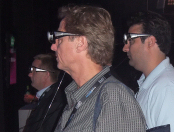The DVB Project has successfully developed digital television systems used throughout the world. The Project Office is located at the EBU Headquarters in Geneva.
The DVB Project began work in 3D-TV at the beginning of 2010. Its plan is to develop standards in two steps. The first system, Phase 1, will be used by those who need to keep existing HDTV set top boxes as the means of receiving 3D broadcasts – though new 3D displays will be needed. The second phase would be used where a new receiver and display can be available.
| Phase 1 to be ready for broadcasters this year
Discussion currently centres on the requirements for ‘Phase 1’ . The Phase 1 format will combine Left and Right eye pictures so they can be treated by an existing set top box as a single HDTV picture. The main elements of the DVB discussion are about which ‘formats’ are to be allowed for the combined L and R picture. One of the important factors to be taken into account is the capabilities of the connector which will be used between the set top box and the display, the HDMI connector. HDMI has published a list of formats that it will ensure can be carried, based on the needs of Blu Ray, Games, and what it understands to be broadcaster’s plans. | |
Opinions in the DVB Project are currently divided about whether simply taking the HDMI formats is enough, or whether other formats should be added for the DVB Phase 1 system. Regular meetings of the DVB Commercial Module group on 3D-TV are held to resolve this. The HDMI group also meets to discuss which formats should be ‘mandatory’ for displays to handle, and which not.
The next weeks and months will be critical for the ‘Phase 1’ 3D-TV system, and broadcasters throughout the world will be watching developments in the DVB project.

 Viewers watching 3D-TV
Viewers watching 3D-TV